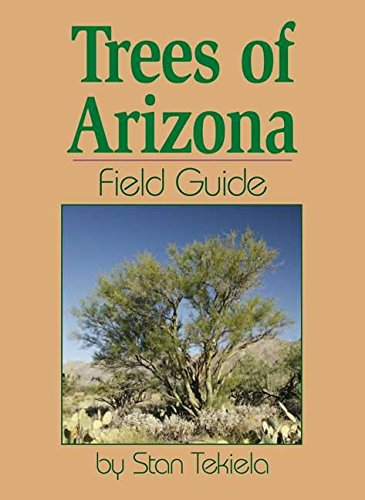
Synopsis
Make tree identification in Arizona even more enjoyable!
Now tree identification is simple and productive.
- 135 species―only Arizona trees! No need to look through dozens of photos of trees that don’t grow in Arizona
- Fact-filled information and stunning, professional photographs
- Easy-to-use thumb tabs showing leaf type and attachment and compare feature showing average tree height
- Stan’s Notes, including naturalist information and gee-whiz facts
"synopsis" may belong to another edition of this title.
About the Author
Naturalist, wildlife photographer and writer Stan Tekiela is the originator of the popular state-specific field guide series. Stan has authored more than 190 educational books, including field guides, quick guides, nature books, children’s books, playing cards and more, presenting many species of animals and plants. With a Bachelor of Science degree in Natural History from the University of Minnesota and as an active professional naturalist for more than 30 years, Stan studies and photographs wildlife throughout the United States and Canada. He has received various national and regional awards for his books and photographs. Also a well-known columnist and radio personality, his syndicated column appears in more than 25 newspapers, and his wildlife programs are broadcast on a number of Midwest radio stations. Stan can be followed on Facebook and Twitter.
Excerpt. © Reprinted by permission. All rights reserved.
Quaking Aspen
Populus tremuloides
Family: Willow (Salicaceae)
Height: 40-70' (12.2-21 m)
Tree: slender tree, straight trunk, lacking any major side branches, round crown
Leaf: simple, nearly round, 1-3" (2.5-7.5 cm) long, alternately attached, with short sharp point, fine- toothed margin, shiny green above and dull green below, leafstalk (petiole) flattened
Bark: dark gray to brown and deeply furrowed lower, greenish white to cream and smooth upper
Flower: catkin, 1-2" (2.5-5 cm) long, male and female bloom (flower) on separate trees (dioecious) in spring before the leaves bud
Fruit: catkin-like fruit, 4" (10 cm) long, made of many tiny green capsules, 1/8" (.3 cm) long, that open and release seeds, seeds are attached to cottony white material and float on the wind
Fall Color: golden yellow
Origin/Age: native, 60-80 years
Habitat: wet or dry, sandy or rocky soils at 6,500-10,000' (1,980-3,050 m); sun
Range: throughout, planted in parks and yards
Stan’s Notes: The most widely distributed tree in North America. Leaves catch gentle breezes and shake or quake in wind. Also known as Trembling Aspen or Popple. Grows in large, often pure stands. Returns from roots if cut or toppled. Most reproduce by suckering off their roots, which creates clone trees. One stand in Utah–106 acres (42 ha) with about 47,000 trees–is the largest single living organism in the world. Has survived lab temperatures of -314 °F (-192 °C).
"About this title" may belong to another edition of this title.
Search results for Trees of Arizona Field Guide (Tree Identification Guides)
Trees of Arizona Field Guide (Tree Identification Guides)
Seller: Greenworld Books, Arlington, TX, U.S.A.
Condition: good. Fast Free Shipping â" Good condition book with a firm cover and clean, readable pages. Shows normal use, including some light wear or limited notes highlighting, yet remains a dependable copy overall. Supplemental items like CDs or access codes may not be included. Seller Inventory # GWV.1591930766.G
Trees of Arizona Field Guide (Tree Identification Guides)
Seller: Goodwill, Brooklyn Park, MN, U.S.A.
Condition: good. All pages and cover are intact including the dust cover, if applicable . Spine may show signs of wear. Pages may include limited notes and highlighting. May include "From the library of" labels. Shrink wrap, dust covers, or boxed set case may be missing. Item may be missing bundled media. Seller Inventory # MINV.1591930766.G
Trees of Arizona Field Guide
Seller: ThriftBooks-Dallas, Dallas, TX, U.S.A.
Paperback. Condition: Good. No Jacket. Pages can have notes/highlighting. Spine may show signs of wear. ~ ThriftBooks: Read More, Spend Less. Seller Inventory # G1591930766I3N00
Trees of Arizona Field Guide
Seller: ThriftBooks-Reno, Reno, NV, U.S.A.
Paperback. Condition: Good. No Jacket. Pages can have notes/highlighting. Spine may show signs of wear. ~ ThriftBooks: Read More, Spend Less. Seller Inventory # G1591930766I3N00
Trees of Arizona Field Guide
Seller: ThriftBooks-Atlanta, AUSTELL, GA, U.S.A.
Paperback. Condition: Fair. No Jacket. Readable copy. Pages may have considerable notes/highlighting. ~ ThriftBooks: Read More, Spend Less. Seller Inventory # G1591930766I5N00
Trees of Arizona Field Guide
Seller: ThriftBooks-Dallas, Dallas, TX, U.S.A.
Paperback. Condition: Very Good. No Jacket. May have limited writing in cover pages. Pages are unmarked. ~ ThriftBooks: Read More, Spend Less. Seller Inventory # G1591930766I4N00
Trees of Arizona Field Guide
Seller: ThriftBooks-Phoenix, Phoenix, AZ, U.S.A.
Paperback. Condition: Good. No Jacket. Pages can have notes/highlighting. Spine may show signs of wear. ~ ThriftBooks: Read More, Spend Less. Seller Inventory # G1591930766I3N00
Trees of Arizona Field Guide
Seller: ThriftBooks-Atlanta, AUSTELL, GA, U.S.A.
Paperback. Condition: Good. No Jacket. Pages can have notes/highlighting. Spine may show signs of wear. ~ ThriftBooks: Read More, Spend Less. Seller Inventory # G1591930766I3N00
Trees of Arizona Field Guide (Arizona Field Guides)
Seller: Bookmans, Tucson, AZ, U.S.A.
Paperback. Condition: Good. . Satisfaction 100% guaranteed. Seller Inventory # mon0001795357
Trees of Arizona Field Guide (Tree Identification Guides)
Seller: HPB-Diamond, Dallas, TX, U.S.A.
Paperback. Condition: Very Good. Connecting readers with great books since 1972! Used books may not include companion materials, and may have some shelf wear or limited writing. We ship orders daily and Customer Service is our top priority! Seller Inventory # S_439466858
